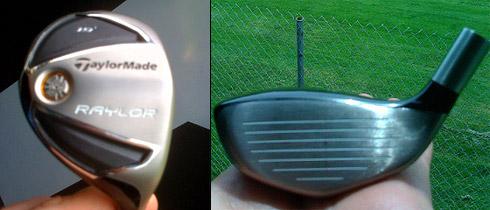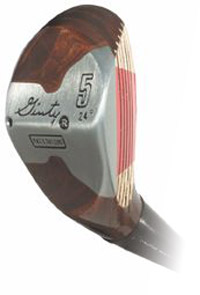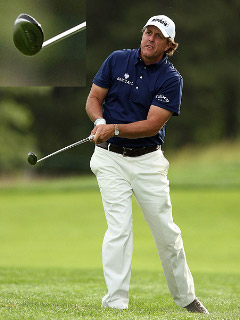 Love them or hate them, hybrids seem to have changed the game for good. There are many long irons sitting in closets and garages right now that may never see the light of day again. Hybrid clubs are a product of the remarkable equipment evolution we’ve seen in the last decade or so. Advances in equipment and course design seem to feed off of each other, with one change spurring others.
Love them or hate them, hybrids seem to have changed the game for good. There are many long irons sitting in closets and garages right now that may never see the light of day again. Hybrid clubs are a product of the remarkable equipment evolution we’ve seen in the last decade or so. Advances in equipment and course design seem to feed off of each other, with one change spurring others.
For example, with the death of the wound golf ball and the introduction of oversize drivers, course designers have responded to the fact that golfers are hitting it further by making courses longer. I read recently about the Pete Dye course at French Lick Resort – it measures a staggering 8102 yards from the back tees. This ridiculous golf course boasts par threes of 251 and 301 yards, no less than five par fours stretching over 500 yards, and the shortest of the par fives is 575 yards, with the longest being 657 yards of pure fun.
Obviously, I’m not a big fan of making golf courses so long that even the best players in the world wouldn’t enjoy it, but that’s a discussion for another day.
The introduction of the Titleist Pro V1 golf ball contributed to this technology “one-upsmanship.” Wound golf balls such as the Titleist Tour Balata and Tour Professional spun at a much higher rate than the Pro V1 ball in 2000/2001. The pros on the professional tours liked this because the new ball spun less, giving them better control of approach shots, and flew higher and straighter than the old wound balls.
Course designers developed courses that are longer, and turf grass researchers started growing grasses that allow for faster, firmer greens. In the South, the advent of TifEagle Bermuda grass has made for much faster and smoother putting surfaces, sometimes making older courses with more green contours virtually unplayable. Greens that once ran at an eight or nine on the stimpmeter now rate in the 11 or 12 range.
In response to the lower spinning golf ball and the longer golf courses with faster greens, there was a need to be able to hit the ball higher and land softer from 200 yards and more. TaylorMade introduced the Rescue, a hybrid club that had some design characteristics of both an iron and a wood. The club had a lower center of gravity and a higher loft than the long irons it replaced, allowing golfers to hit the ball much higher than with a long iron. It also shared the cambered sole and bulge and roll of a wood club, making it more forgiving on off-center hits and easier for the club to glide through tall grass and poor lies.

Shortly after the introduction of the Rescue, Adams golf released the Idea irons, which replaced the two and three irons with easier to hit hybrids. Adams started to promote its clubs on the major professional tours, knowing that sales are largely driven by tour adoption and use. Simply put, if the pros use a club, the rest of us will want to use it too, and the numbers seem to back it up to a certain extent. According to the Darrel Survey, in 2004 seven percent of golfers carried a hybrid. In 2007, that number was up to over 30 percent. By comparison, 65% of PGA Tour players carry at least one hybrid, and that number grows to over 80% on the Champions tour.
At the 2009 U.S. Open at Bethpage Black, the focus in terms of equipment was very much on hybrids. With the course playing very long and wet and the rough up, many players paid visits to the tour vans for help. Vijay Singh put three hybrids in the bag for the week. He carried 19, 22, and 26 degree hybrids from Adams Golf. TaylorMade unwrapped a new hybrid design at the Open and several of their staff tested them out. The new club is called the Raylor. Many may remember the old Raylor fairway woods of the past (see above). This new hybrid features a V-shaped soleplate to cut through the grass. To me it looks a bit like the old wooden Ginty club I once had. Compare for yourselves and see.
 For the week at Bethpage, a total of 70 players carried at least one hybrid, and only ten players carried a two iron. In all, there were 147 hybrid clubs in play on the monster layout. There was no better endorsement for TaylorMade’s hybrids than the stellar first round 64 of Mike Weir, using a 19 degree hybrid to hit it close and make three birdies along the way.
For the week at Bethpage, a total of 70 players carried at least one hybrid, and only ten players carried a two iron. In all, there were 147 hybrid clubs in play on the monster layout. There was no better endorsement for TaylorMade’s hybrids than the stellar first round 64 of Mike Weir, using a 19 degree hybrid to hit it close and make three birdies along the way.
Phil Mickelson also made news, playing a Callaway prototype hybrid he helped design. The club, seen below, has a unique shape, looking almost like a wedge. This allowed Phil to actually open the face and hit the club from a variety of distances. In fact, on Friday on the 15th hole, he managed to hit the club from only 164 yards by doing just that. There is no word on whether the new hybrid design will make it into production. As he told Golfworld’s Michael Johnson: “I actually [took] the back part of the hybrid out so I can open it way up and get through that thick rough. I dug in after it and was able to get it there.”
 Even though hybrids have been around for almost 10 years – and for decades before that if you go back to the original Cobra Baffler – and they have been widely adopted by amateur golfers around the world and on all the professional tours, television announcers can’t seem to figure out what to call them. Just this weekend on the various television broadcasts, I heard hybrids referred to as utility clubs, utility irons, iron woods, rescue clubs, utility metals and hybrid long irons. It seems like golf broadcasters need to get together and standardize on one name and simply call them what they are, a hybrid.
Even though hybrids have been around for almost 10 years – and for decades before that if you go back to the original Cobra Baffler – and they have been widely adopted by amateur golfers around the world and on all the professional tours, television announcers can’t seem to figure out what to call them. Just this weekend on the various television broadcasts, I heard hybrids referred to as utility clubs, utility irons, iron woods, rescue clubs, utility metals and hybrid long irons. It seems like golf broadcasters need to get together and standardize on one name and simply call them what they are, a hybrid.
Of course, this naming confusing also happened back when TaylorMade gave us the original confusing club: a wood (driver) made of metal. Despite the paradox, these metal clubs eventually became known as metal woods. Hybrids are here to stay, they have changed the game for many golfers and I look forward to seeing what the club companies can come up with next – that is, if the USGA doesn’t step in and ruin the party.
This article was written by a guest author. If you’d like to contribute, send us an email.
Photo Credits: © Golf.com, © Louisville Golf, © Sam Greenwood.

Im a huge fan of hybrids, even though im a low handicap. There is some kind of macho stigma agaist playing hybrids amung better players, and i never really got it. I play two now and I forsee even playing a 3rd as i get into my mid 30’s. They make the game so much easier to play and enjoy.
Besides replacing the 3 & 4 irons, I’m seeing people replace their fairway woods with hybrids (especially the 5 wood.)
I think of hybrids as “easier to hit” versions of an iron. Years ago people replaced their 1 & 2 irons with fairway woods. Could we be seeing things come back full circle, with fairway woods eventually replaced (for the most part) by hybrids (the modern version of 1 & 2 irons)?
Love the hybrids!!Carry 2,4,6 and by altering the position of my hands on the shaft it covers a huge amount of territory! Long Irons are dead to me
That new Callaway design seems pretty cool, and how Mickelson hit it only 164 yards, that’s just awesome.
I guess I never did realize how stupid “metal woods” sounds.
I’ve considered putting my old 3-hybrid and 4-hybrid back in the bag for some time now. Weir’s round really did affect me, and I think I’m going to do that now.
Wow that one Mickelson used looks pretty crazy. That thing is so tiny! It must be less forgiving than most hybrids, but it could be a true “rescue” club. It’s kind of a cool idea.
Thanks for pointing out the new equipment, TST.
it’s a matter of time before they become common place on tour. if a pro is unabashed about using a belly putter with a head shaped like the USS Enterprise, a hybrid is darn near macho by comparison. also, as younger players come onto the tour, they will have grown up with hybrids and would think nothing of putting one or more in the bag. they won’t even know what a 2-iron was, let alone consider hitting one. anyone here referencing a 2-iron is showing his age !!! LOL
Paper weights anyone?
😆
Quite frankly, I nearly avoided using fairway woods in an effort to concentrate on hybrids. One can very easily replace a 3w with a 2h with minimal loss of yards, and even a 5w for a 3h.
I decided to go a half way and only bought one hybrid, 3h, and I got a 3w instead of the 2h. And the reason for it is that for me…I didn’t feel comfortable hitting a hybrid off the tee.
My hybrid was once just a club in my bag, but since I got the 3/R Cobra DWS it is my got to in the 180-200 range. I sometimes use it knowing I’m well short of 180, but I just don’t get that distance from my 4i.
So my current debate is whether to replace my 4i with a 4h, or continue to hammer my issues out and improve so that the 4i carries some of the load!
I love the hybrids, and I hope that the USGA doesn’t go crazy limiting these clubs. They make the game much more enjoyable!